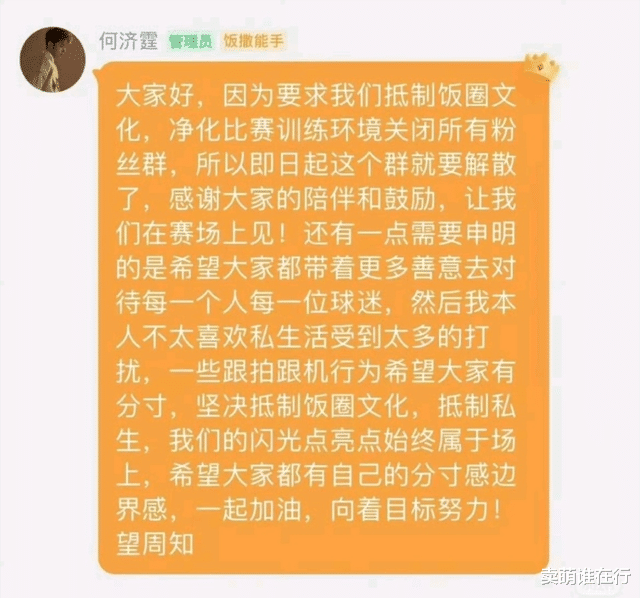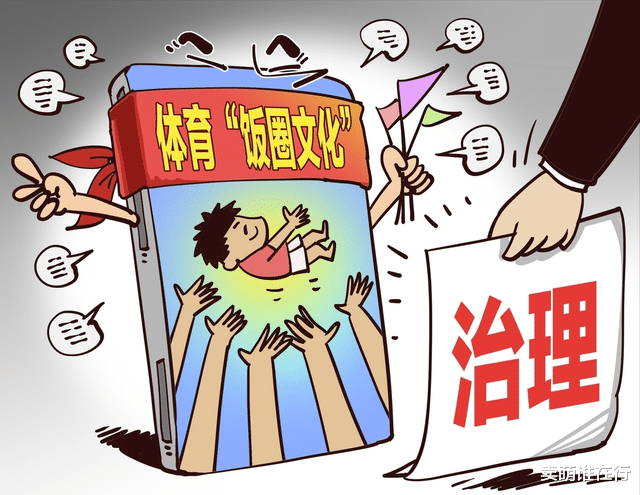Recently, several athletes and coaches from the Chinese badminton team have disbanded their fan groups, drawing significant public attention. This move has been widely supported by public opinion, with some netizens asking, "When will the national table tennis team disband their fan groups?" The national table tennis team responded quickly and quietly, with Wang Chuqin dissolving his own fan group.
Why did multiple national badminton athletes and Wang Chuqin dissolve their fan groups within a short period of time? This time, there seems to be a consensus among all parties to crack down on the fan circle culture.
The last "message" left by the national badminton athletes before dissolving their fan groups
On January 14th, at the special meeting on ideological work in the sports bureau system and the governance of the "fan circle" chaos, Gao Zhidan, director and party secretary of the General Administration of Sport, pointed out that the governance of the "fan circle" chaos should be treated as an urgent task to be seized and implemented.

Of course, this is not the first time the General Administration of Sport has publicly stated its intention to severely rectify the fan circle culture. As early as May last year, the General Administration of Sport expressed at the national sports publicity and culture conference that the national sports system will resolutely resist the erosion of the distorted "fan circle culture" in the field of sports throughout the process. It was also emphasized at the meeting that the chaos in the "fan circle" is extremely detrimental to the healthy growth of athletes, the ability of teams to win glory for the country, and the sustainable development of the sports industry. Sports should not and cannot become the "spark" and "incubator" for the continued breeding of the distorted "fan circle culture." Solving this problem is urgent, and the entire national sports system must be highly vigilant and act quickly.
During the Paris Olympics, there were indeed cases where insulting, spreading rumors, and cyberbullying of athletes, coaches, and other personnel were dealt with. However, it is clear that the statements made by the General Administration of Sport in May and the crackdown during the Paris Olympics did not wake everyone up. After the Olympics, there are still frequent occurrences of publishing false information online, insulting and slandering related athletes, coaches, referees, etc., or participating in and instigating conflicts between fan groups.
Why does the domestic sports fan circle seem to be getting worse despite the General Administration of Sport's repeated emphasis on cracking down on fan circle culture?
This all started with the Rio Olympics.

Before 2016, the most common distance between athletes and fans (sports enthusiasts) was that you were on the court, and I was in the stands. You set off, and I see you off; you return, and I pick you up at the airport; after your match, I wait for you at the hotel entrance, ask for autographs, take photos, and send two bouquets of flowers. This is a relatively comfortable distance for many star athletes to chase stars.
But all the turning points happened during the Rio Olympics.
Around the Rio Olympics, with the surge of nationalism, the Chinese table tennis team and athletes from the Chinese women's volleyball team, diving, swimming, and other sports with outstanding athletic performances gained countless fans.
It was around this time that short video live broadcast software began to emerge, combining with these athletes who had gained countless fans. At that time, a platform invited Fu Yuanhui to live broadcast for an hour, attracting over ten million viewers; gifts such as Porsche rain, royal yacht rain, Ferrari rain, plane rain, and taking you to see the sea rain had already drowned Fu Yuanhui's face.

Through short video live broadcasts and other methods, the public saw a side of these athletes that was previously unknown, and short videos also narrowed the distance between athletes and fans. It was from then that many fans who originally knew little about sports began to emerge in large numbers, and more support organizations were born.
As the number of fans increased, on the positive side, the data and ability of fans to create topics enhanced the market value of certain sports stars and teams, allowing them to receive more endorsements. However, on the negative side, as the number of fans increased, it also meant that the quality of fans became mixed, and from after the Rio Olympics, there began to appear "interest chains" related to athletes; for example, selling athlete personal information, selling signed photos, and selling athlete-related products. Crazy fans began to follow planes and hotels; wherever the athletes went, there would naturally be a large number of fans gathering.
The spread of fan circle behavior has also made the sports circle's public opinion environment murky. In the past, during international competitions, the general view was "whoever wins is a victory for China." But now, fan circle conflicts have become commonplace, especially during the women's singles final of the Paris Olympics, the terrifying power of the fan circle at the scene in Paris turned Chen Meng into a "public enemy." On the internet, the fan circle can also create so-called "handles" through rich imagination, gradually transforming into irrefutable evidence in the information cocoon room, bringing huge public opinion and increasing troubles to the parties involved.
On one side is "interest," and on the other is "trouble." How should athletes and teams make choices in this dilemma?

For athletes like Fan Zhendong, Pan Zhanle, and Zheng Qinwen, who have delivered impressive results and follow the route of strength, they chose to keep a distance from the fan circle early on and cut ties in time. However, when the trend of "interest" also becomes an opportunity for "transformation," some athletes' teams and certain sports teams began to actively approach the fan circle. Under such circumstances, the national table tennis team became a very special case.
After Liu Guoliang became the head of the national table tennis team, he has been working hard to promote the professionalization of table tennis. And moving towards professionalization means that the commercial transformation of the national table tennis team and the WTT promoted by Liu Guoliang himself will choose to embrace the market! The way they took was to combine with the rise of short videos, starting various marketing topics and strengthening contact with fans; successfully creating multiple athlete personal IPs, capturing the flow market, and becoming internet celebrities; their image transformed from the original single "athlete" to "national idol," and multiple high-quality personal IPs supported the big IP of the national table tennis team.
And the national table tennis team, with good results, many fans, and great traffic, naturally became the darling of advertisers; not only has the commercial operation of the national table tennis team become increasingly impressive, but the main athletes of the national table tennis team have also become richer, and the WTT promoted by Liu Guoliang himself has successfully relied on the Chinese table tennis market to make money in the past few years.
However, when Liu Guoliang pushed the national table tennis team to actively embrace the market and narrowed the distance with fans, he apparently did not realize that the wave of the fan circle would be so fierce in the future, and even "consume" him, leading to a cliff-like decline in his personal reputation. The stench of fan circle culture, the emergence of information cocoons, and the continuous demonization of social media and short video platforms have made the fan circle problem serious enough to seriously disrupt the ecological balance of the sports circle. The sports fan circle has reached a point where it must be seriously dealt with; the special meeting on fan circle governance by the General Administration of Sport and the actions of multiple athletes to disband their fan groups are just the opening moves.
Next, relevant parties will not only severely crack down on certain behaviors and remarks of extreme fans (accounts); more importantly, they will reorganize related institutions and strike hard at the source that indulges the fan circle, to prevent the re-invasion of fan circle culture in the sports circle! Let the distance between athletes and fans gradually return to the correct track of "cheering outside the track."